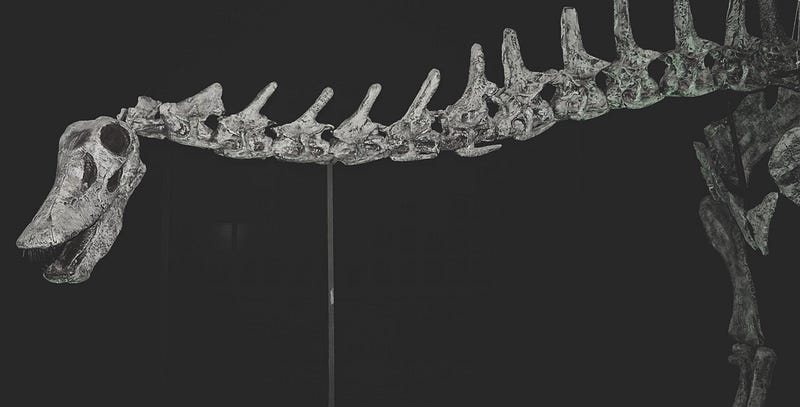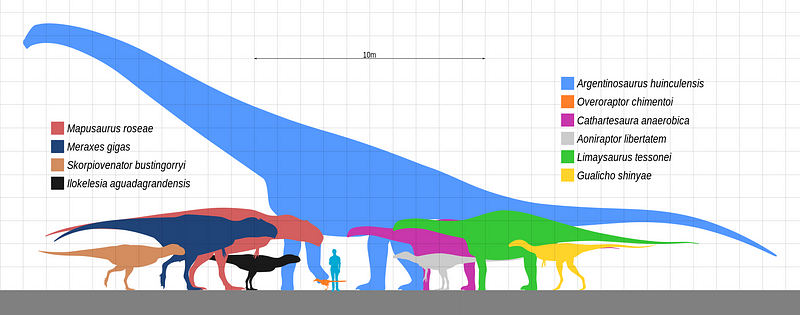A New Era in Paleontology: Discovering Sidersaura marae
Written on
Chapter 1: Introduction to Sidersaura marae
Introducing Sidersaura marae, the inaugural dinosaur to be officially named in 2024, hailing from Argentina. This remarkable species roamed the earth over 90 million years ago and is categorized within the sauropod family, which includes some of the largest land animals in history.

Discovery and Characteristics
The new genus was established based on the remains of four distinct individuals excavated from the Huincul Formation in Neuquén province, Patagonia, Argentina. Dr. Lucas Nicolás Lerzo, a paleontologist affiliated with Fundación Azara — Universidad Maimónides and CONICET, stated, “The findings include sacral vertebrae, a partially articulated tail, hind limb bones, skull fragments, and tail vertebrae.”
He emphasized that having multiple specimens with overlapping anatomical features enabled a comprehensive understanding of this new sauropod dinosaur. Unique to Sidersaura are the star-shaped hemal arches in its tail and its unusually robust skull bones, differing from its closest relatives. Furthermore, it possesses a notable frontoparietal foramen, a distinctive opening in the skull's roof.

The newly identified dinosaur features a long neck, an extended tail, and sturdy, pillar-like legs. It is estimated to have reached lengths of 18 to 20 meters (59 to 66 feet) and weighed around 15 tons, marking it as one of the largest rebbachisaurid sauropods.
Exploring the Rebbachisaurid Family
Rebbachisaurids, a subfamily of sauropod dinosaurs, were spread across continents including South America, Africa, North America, Europe, and Asia. They are particularly recognized for their unique teeth, with some species possessing tooth batteries similar to those found in hadrosaur and ceratopsian dinosaurs. Dr. Lerzo noted, “Rebbachisaurids played a significant role in Cretaceous ecosystems and faced extinction around 90 million years ago.”
Sidersaura marae stands as one of the last rebbachisaurids while also representing an ancient lineage. “This indicates that even towards the end of their existence, early rebbachisaurids persisted, and they were among the largest of their kind, reaching nearly 20 meters in length.”
Dr. Lerzo concluded that the discovery of Sidersaura implies a more intricate evolutionary history for the Rebbachisauridae than previously understood.

Chapter 2: Ecosystem Insights from Huincul Formation
Sidersaura is primarily known from the Late Cretaceous Huincul Formation in Río Negro Province, where a rich diversity of fossils has been uncovered. This region has yielded some of the largest herbivorous and carnivorous dinosaurs, including the gigantic Argentinosaurus, a titanosaur reaching lengths of 35 meters (115 feet) and weighing over 60 tons, and Mapusaurus, a carcharodontosaurid comparable to Tyrannosaurus rex.
The Huincul Formation has also yielded fossils of Cathartesaura and Limaysaurus, two closely related rebbachisaurid sauropods. In addition, various abelisaurids (like Skorpiovenator, Tralkasaurus, and Ilokelesia), carcharodontosaurids (such as Meraxes and Taurovenator), megaraptorans, and additional titanosaur sauropods have been discovered in these sediments.

Epilogue: Significance of Sidersaura Discovery
The identification of Sidersaura is crucial for paleontologists, as it provides insight into the era when rebbachisaurids were nearing extinction, enhancing our understanding of their evolutionary trajectory. As we move further into 2024, we anticipate even more thrilling discoveries!
Relevant Reads
- Scientists Confirm the Discovery of Australia’s Largest Dinosaur
- Australotitan is among the largest dinosaurs to have ever existed worldwide...
- Brontosaurus & Its Kin: The Iconic Giants of the Jurassic
- Meet some of the longest creatures to have ever walked the Earth…
- The Dinosaur That Went Extinct Twice
- The confusing story of the mighty Brontosaurus…
Sources
Lucas Nicolás Lerzo et al. The last of the oldies: a basal rebbachisaurid (Sauropoda, Diplodocoidea) from the early Late Cretaceous (Cenomanian-Turonian) of Patagonia, Argentina. Historical Biology, published online January 3, 2024; doi: 10.1080/08912963.2023.2297914.